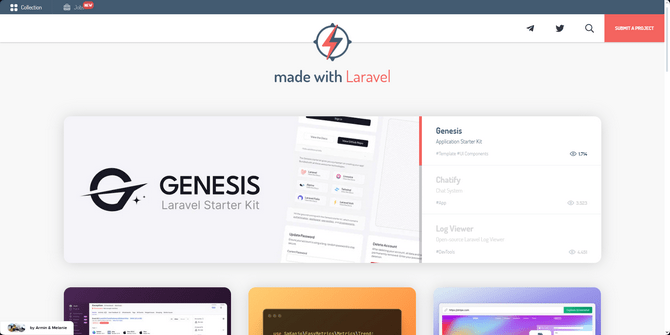Laravel Tutorial
Welcome to our Laravel tutorial! In it, we will tell you everything you need to know about Laravel: what it is, how it works, its components, and its inner workings. We will even show you a simple application at the end. It is one of the most popular PHP frameworks, as evidenced by the nearly two million websites built with it.
If you are looking for information about Laravel or just stumbled upon this tutorial, we will answer your questions about the framework. And, where better to start this tutorial than right where Laravel took off from?
This Overview Includes:
Where it Began
Laravel 1 was released in June 2011 as a response to the lacking features of the then-reigning PHP framework Codeigniter. It was developed by Taylor Otwell, who remains Laravel's CEO to this day. The framework sought to provide an alternative to developers who wanted to use PHP but found that Codeigniter's features needed improvement.
Right out of the gate, Laravel had several useful features that other PHP frameworks did not have: authentication, Eloquent ORM for database operations, localization, models and relationships, simple routing mechanism, caching, sessions, views, extendibility through modules and libraries, and HTML helpers. We will explain these features later in this tutorial, as we wanted to show you just how feature-rich Laravel was on release.
Laravel 2 came out only a few months after version 1, in November 2011. It was a huge step for the framework, adopting the MVC (Model-View-Controller) architecture it has used since. Again, we will explain what that means later on. November was a massive month for Laravel, but the updates did not stop there.
Throughout the years, Laravel has steadily improved and grown. With its popularity and dedicated team behind it, we expect Laravel to continue prospering in the future as well. If the growth in the number of websites using it is any indication, it shows no signs of slowing down. Let's move on to the next logical question: What exactly is Laravel, the PHP framework?
Open-source PHP Framework
Let's begin with PHP. PHP is a general-purpose scripting language perfect for web development due to several factors: easy to use, open-source, and cross-platform. Many hosting servers are built on PHP, for instance. It allows developers to program almost anything and everything, and it is an excellent language that has been recognized worldwide for decades now.
A PHP framework takes things one step further. Simply put, a PHP framework is founded on the PHP language but also incorporates various features to speed up and streamline the development process. PHP itself is incredibly robust since it has been around for a while and has received countless updates and improvements over the years. It is not surprising, then, that PHP frameworks themselves would be innately robust. WordPress is an example: it is built entirely in PHP and powers over 40% of websites nowadays.
However, WordPress is a fully-blown Content Management System that is built on PHP. Laravel, on the other hand, is a PHP framework that can do what WordPress does (build websites), but it can also do so much more than that. It can create websites and almost any sort of web application you can think of. Not only that, but since it is a framework, it comes with many functionalities already baked into it that can streamline your development process: security, authentication, routing, HTML templating, and so on).
A Laravel application is highly scalable, and functionalities can be added or removed seamlessly. While WordPress can build a solid website with some good functionality —but limited by plugins—Laravel can build a solid website with the ability to expand its functionalities as necessary without limit.
So, that is what Laravel is. WordPress' bigger, more sophisticated brother. It is a PHP framework used to build web applications, from websites to games, automation services, and beyond.
Examples of Laravel Applications
Before we move on to the technical part of our tutorial, let's look at some examples of websites built with Laravel. We strongly encourage you to click through them and see their functionalities. That should give you a great idea of what Laravel can do for you.
Invoice Ninja

Invoice Ninja is an open-source invoicing solution that can process payments, monitor expenses, generate custom invoices, and curate proposals in one place. It is based on the SaaS model of services, making it very flexible regarding where it is hosted. It can be hosted on a user's server or a public cloud without issues. It currently serves more than 170,000 users and offers quick and easy invoicing solutions.
Alison

A leading eLearning platform, Alison was launched in 2007 and has since built a community of over 20 million users in more than 190 nations. The platform offers courses on various topics, specializations, and diplomas in sales and marketing, IT, health, business, language, personal development, management, engineering and construction, teaching and academics, and so on.
Barchart

With nearly four million users worldwide, Barchart boasts a robust suite of fundamental or technical research tools across domestic and global markets. It can provide traders and investors with comprehensive overviews of trends in cryptocurrencies, stocks, forex, futures, and more.
AlphaCoders.com

AlphaCoders is an excellent alternative to DeviantArt. Built with Laravel, it offers artists a space to share their creations and fans a space to connect with their favorite artists. It has an excellent interface and intuitive search engine and houses thousands of wallpapers, gifs, and avatars.
MadeWithLaravel

Before we finish this part of our tutorial, we also want to offer you another website that is not only built with Laravel but also offers countless Laravel projects you can download and start using immediately. There is a section at the end of our tutorial about useful resources, but we also wanted to mention madewithlaravel.com here, as it is an excellent resource for pre-made projects. Some of these projects are almost entire websites on their own, so don't hesitate to check them out.